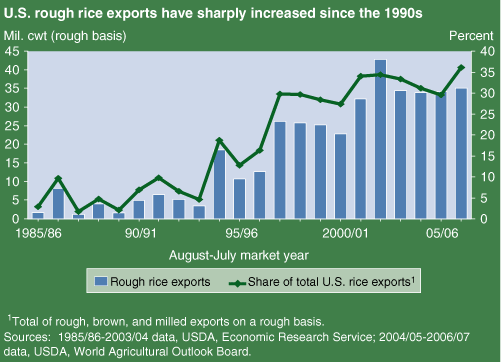Rough Rice Exports Critical to U.S. Rice Producers
- by Nathan Childs
- 2/1/2007
U.S. rough (unmilled) rice exports have grown sharply since the mid-1990s, and account for about a third of annual U.S. rice exports, double the share of a decade ago. Growth in U.S. rough rice exports has partially offset a loss of market share in the global milled rice trade to lower cost Asian exporters, primarily Thailand, the world’s largest rice-exporting country. While the U.S. is the fourth largest rice exporter, behind Thailand, Vietnam, and India, the U.S. share of global trade of all rice dropped from 20 percent two decades ago to 13 percent in 2006. About half of the U.S. crop is exported annually, making exports critical to the economic well-being of the U.S. rice sector.
The U.S. is the only major rice exporter that ships rough rice. None of the Asian exporters allow rough rice to be exported, preferring to keep the value added from milling. Rough rice accounts for just 4 percent of global rice trade, with the United States accounting for nearly all shipments.
Mexico and Central America, the largest markets for U.S. rough rice, purchase long grain, the dominant class of rice grown in the United States. These countries typically account for more than 90 percent of U.S. rough rice exports, with the United States supplying nearly all of their imports. Shipments to these markets have substantially increased since the mid-1990s. Importers in these countries prefer rough rice to milled rice because tariff rates are much lower on rough rice. None of these countries has the ability to significantly boost production. Mexico’s rice production is less than half the level harvested 20 years ago, and production has declined in much of Central America as well, primarily due to policy changes that have reduced import protection and lowered domestic support and to more profitable cropping options. Mexico and Central America have substantial excess milling capacity as well, further boosting the incentive to import rough over milled rice.
Energy costs and global trade policy are two sources of uncertainty facing the U.S. rice sector. First, the U.S. may not remain competitive in the global rice market if energy prices do not fall. Rice is a high-cost crop to grow in the U.S., primarily due to much higher expenses for fuel—to operate irrigation facilities—and more fertilizer than is required for other field crops. Second, a more open global trading environment would increase market access for U.S. producers because rice is a highly protected commodity, especially in Northeast Asia. However, any trade agreement that results in reduced producer support would have negative impacts on U.S. rice producers because government payments account for a much larger share of rice producers’ income than for most other U.S. program crops.
This article is drawn from:
- Childs, N. & Livezey, J. (2006). Rice Backgrounder. U.S. Department of Agriculture, Economic Research Service. RCS-200601.
You may also like:
- Rice. (n.d.). U.S. Department of Agriculture, Economic Research Service.



